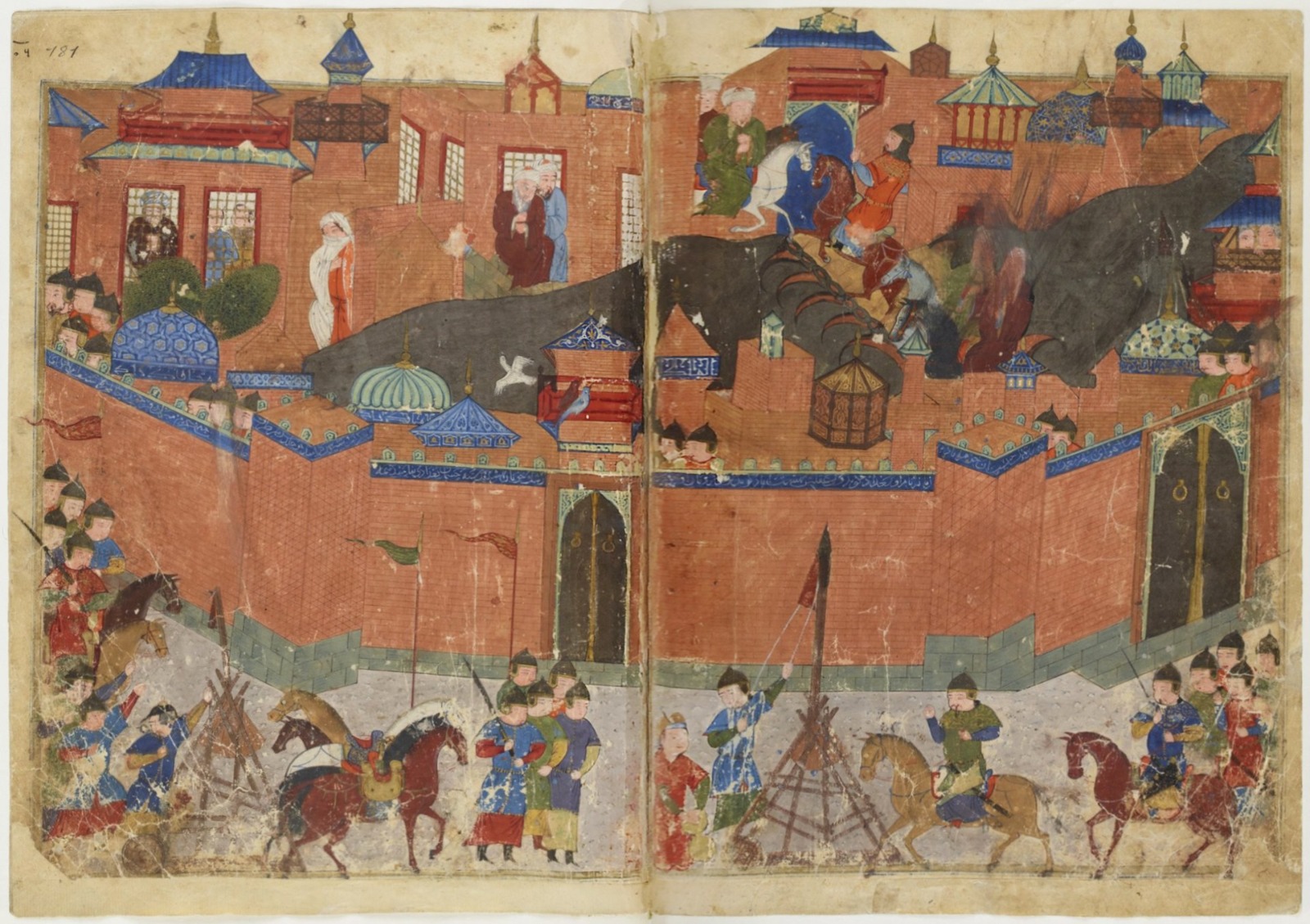By the end of the 12th century, Mongol power had grown in Eastern Asia, with Chinggis (Genghis) Khan ruling over a nomadic empire by 1206 CE. In 1217, a devastating attack was launched on Iran due to provocation by a local ruler. The end result was the destruction of centuries-old centres of Islamic civilisation, and the massacre and displacement of huge populations.
In 1256 CE, Chinggis’ grandson, Hulagu, renewed the push towards the West in order to secure control over Iran and Iraq, eliminating all challengers to Mongol domination. These included the Ismāʿīlī Assassins in their castle of Alamūt in northern Iran, and the Abbasid caliphs of Baghdad.
Hulagu’s Expedition
Hulagu’s main objective was to bring under control those rulers in the Middle East who had not submitted to the Mongols.
In 1253 CE, he left Mongolia marching across central Asia. First, he turned his attention towards the Ismāʿīlī Assassins at Alamūt – whom he defeated in 1256.
With the elimination of the Assassins, Hulagu turned his gaze towards Baghdad – the capital of the Abbasid Caliphate. The caliph and some Ayyūbid princes were among those who had not formally submitted to Mongol overlordship, even though they had sent tribute to Möngke in the past.
Hulagu had a further reason to chastise the Abbasids: during his first campaign, he had asked the caliph for reinforcements in his operations against the Ismāʿīlīs. The caliph was initially reluctant to comply, as his ministers and amīrs advised him that the purpose was to weaken Baghdad’s ability to resist a siege.
Ultimately, no troops were sent.
The Decline of the Abbasids
Despite still having some residual authority, the caliphate had greatly diminished in both influence and power.
There had been something of a revival under the Caliph, al-Muṣtansir, but his son, al-Musta’sim, was more fond of indulging in pigeon-racing and other pastimes, rather than looking after the affairs of state. The responsibility for these, he delegated to his vizier, Ibn al-ʿAlqamī, a Shia Muslim who was keenly aware of the decline of the caliphate and the rise of the Mongols.
March on Baghdad
After resting his troops in the summer of 1257 CE, Hulagu made his way through Iran, brushing aside all attempts to block his progress. In the autumn of 1257, he demanded the surrender of the caliph.
When Mongol emissaries arrived to demand the caliph’s submission, the caliph deludedly warned them of the dire consequences of an assault on the city, despite receiving warning messages from his generals that they could not withstand such an attack.
He also remained blissfully unaware that his vizier was secretly negotiating with the Mongols.
The Siege of Baghdad
Hulagu approached the assault on Baghdad with caution, as the city had a large population and a formidable army. The Mongols knew that previous enemies of Baghdad had all failed, and the city was thought to have an image of invincibility.
Upon reaching the city, the Mongols began a close siege, setting up positions all around the city.

The siege of Baghdad began towards the end of January 1258 CE, when Hulagu and his multi-ethnic army converged on the city from all sides.
Although there are differing accounts surrounding the fall of the city, many historians of the time blamed the treachery of Ibn al-ʿAlqamī – the vizier of the last Abbasid caliph – for inviting Hulagu to take the city and persuading the caliph and Sunni elites to come to Hulagu’s camp. This resulted in their eventual death, the sacking of the city, and the massacre of its inhabitants.
On the 10th of February, the caliph surrendered to Hulagu, and left whilst the besiegers took the city. Three days later, on the 13th of February, the destruction of the city began.
The Pillaging of Baghdad
The pillaging of Baghdad was a traumatic event of devastation that involved looting and killing on a grand scale. The famous city, once the most populous in the world, was razed; its priceless treasures lost, and countless numbers killed.
Historians at the time estimated that the victims numbered from the hundreds of thousands up to two million. The casualties were also increased by outbreaks of epidemics.
Despite the widespread destruction, some groups and individuals managed to survive the conquest by submitting, paying, and possessing special skills. Safe conduct away from the city was granted to the Christians and Shia.
Execution of the Caliph
The caliph was brought before Hulagu, who had been reluctant to execute him based on negative predictions from a court astrologer.
However, following an alternative view from the famous Shi’i astronomer, Naṣīr al-Dīn al-Ṭūsī, the decision was taken to put al-Musta’sim to death.
Once again, there are differing accounts. Some Arabic sources claim the execution was carried out by wrapping the caliph in a carpet and having him trampled to death, so as to avoid spilling his blood, which would bring about ill fortune according to Mongol values.
In an alternative account, al-Musta’sim was made to confront all the treasure he had hoarded and failed to spend on the defence of his city and people. He was then imprisoned, surrounded by nothing but his hoarded treasure for sustenance, and starved to death.

End of the Abbasids
The death of al-Musta’sim marked both the end of the Abbasid dynasty – which had lasted for over 500 years – and the end of a caliphate with any semblance of independent power.
The fall of Baghdad and the death of the caliph was not just another grim incident in an era of rise and fall of dynasties, it was a momentous event in world history that left a strong impression on both contemporaries and posterity alike.
Source: Islam21c









